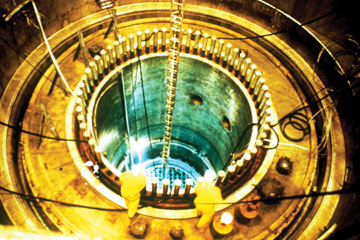|
NEWS NOTES
Thorium fuels nuclear comeback
 NRC |
| Nuclear reactor core. |
Nuclear energy is in fashion again — but while many consider its minute carbon footprint a primary selling point, questions about long-term waste storage and proliferation potential persist. These concerns are prompting governments and industry to reexamine nuclear fuels that are based on thorium rather than uranium.
Interest in thorium as a nuclear fuel began in the 1960s. Back then, many people envisioned tens of thousands of nuclear reactors would be running by now and they worried that economically recoverable uranium reserves would not meet the projected demand. However, the United States largely abandoned the idea of thorium when the country’s exploitable uranium resources were deemed much larger than originally thought. Now thorium may move into the spotlight again, thanks to its wide availability and fewer proliferation concerns.
Sen. Orrin Hatch, R-Utah, plans to introduce the Thorium Energy Independence and Security Act in Congress this year. The bill is intended to lay the regulatory groundwork for the development of commercial thorium reactors in the United States and calls for demonstration projects at the U.S. Department of Energy’s Idaho National Laboratory, as well as international partnerships, according to a source in Hatch’s office. Several countries, including Norway, Russia and Canada, already have thorium research and development programs, but the most active one is in India, a country that boasts little domestic uranium but one of the largest thorium reserves in the world.
Thorium has several advantages over uranium. First, generating nuclear power using thorium produces significantly less transuranic waste — nasty material that contains plutonium and other elements heavier than uranium — which can remain highly radioactive for hundreds of thousands of years. “For long-term waste sequestration, these [elements] are the biggest problem,” says Michael Driscoll, a nuclear engineer at MIT in Cambridge, Mass.
Second, unlike uranium, the material that comes out of a thorium-fueled reactor is extremely difficult to turn into weapons, thereby offering “some serious impediments to proliferators,” says Thomas Marcille, a nuclear engineer at Los Alamos National Laboratory in New Mexico. Thorium doesn’t breed plutonium. That is an important factor as the international community’s concerns about potential misuse grow. “The world — and the U.S. specifically — have a much more sensitive perspective with respect to proliferation concerns today,” he says. Instead, thorium breeds uranium-233, which can, theoretically, be used in weapons, but because it always occurs together with the highly radioactive uranium-232 isotope, it is essentially self-protecting. Handling these toxic materials would require such highly sophisticated radiation shielding and processing facilities that it all but assures nonproliferation.
Thorium is also gaining popularity because it is three to four times more abundant in Earth’s crust than uranium, according to the American Nuclear Society. Because of nuclear energy’s comeback worldwide, “we anticipate a dramatic increase in the number of deployed commercial nuclear reactor systems and that will put pressure on the uranium market and the uranium supply system,” Marcille says. That “will naturally incentivize people to look for affordable options,” such as thorium.
Where thorium runs into trouble, however, is that it is currently not economically competitive with uranium because the United States uses open fuel cycles — fuel is used only once and then is discarded rather than being reprocessed, Driscoll says. However, “to get good use out of thorium you have to reprocess,” he says. Out of proliferation concerns, the United States stopped reprocessing spent nuclear fuels in the late 1970s, which was one of the reasons why thorium did not take off back then, he adds. (Reprocessed fuel leaves behind weapons-grade plutonium.) But given probable shortages in the uranium market and proliferation concerns, thorium fuels are becoming more attractive, and there are ways to make them more economical as well. For example, open-fuel thorium cycles could become competitive if the United States decided to credit reactor operators for minimizing their production of transuranic waste or charge them for producing it, Marcille says. This is not a concern in other countries, such as Russia and India, which do reprocess their nuclear waste. Despite this economic hurdle, Marcille says, “just the abundance of thorium and the issue of non-proliferation unto themselves provide enough incentive for us to look at it again. And that’s what people are doing now.”

 Subscribe
Subscribe


